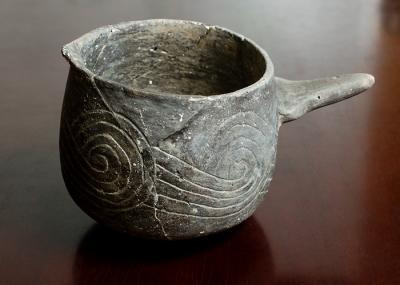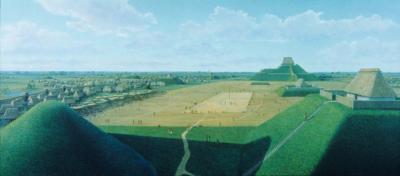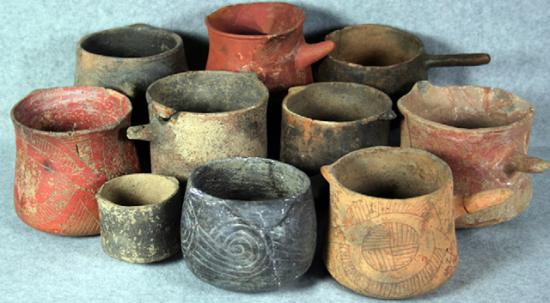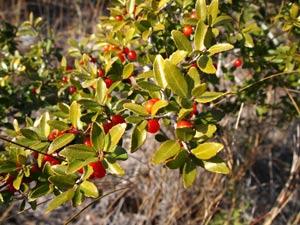Researchers find evidence of ritual use of 'black drink' at Cahokia
University of Illinois at Urbana-Champaign
Source - http://www.eurekalert.org/pub_releases/2012-08/uoia-rfe080112.php

Residents of Cahokia, a massive pre-Columbian settlement near the confluence of the Missouri and Mississippi Rivers, consumed "Black Drink" from special pottery vessels like this one. Credit: L. Brian Stauffer
People living 700 to 900 years ago in Cahokia, a massive settlement near the confluence of the Missouri and Mississippi Rivers, ritually used a caffeinated brew made from the leaves of a holly tree that grew hundreds of miles away, researchers report.
The discovery – made by analyzing plant residues in pottery beakers from Cahokia and its surroundings – is the earliest known use of this "black drink" in North America. It pushes back the date by at least 500 years, and adds to the evidence that a broad cultural and trade network thrived in the Midwest and southeastern U.S. as early as A.D. 1050.
The new findings, published in the Proceedings of the National Academy of Sciences, highlight the cultural importance of Greater Cahokia, a city with as many as 50,000 residents in its heyday, the largest prehistoric North American settlement north of Mexico.
"This finding brings to us a whole wide spectrum of religious and symbolic behavior at Cahokia that we could only speculate about in the past," said Thomas Emerson, the director of the Illinois State Archaeological Survey and a collaborator on the study with researchers at the University of Illinois, the University of New Mexico, Millsaps College in Mississippi and Hershey Technical Center in Pennsylvania. The Archaeological Survey is part of the Prairie Research Institute at the U. of I.
University of New Mexico anthropology professor Patricia Crown and Hershey Technical Center chemist Jeffrey Hurst conducted the chemical analyses of plant residues on the Cahokian beakers, a project inspired in part by a similar analysis they led that found that people living in Chaco Canyon, New Mexico, in A.D. 1100-1125 consumed liquid chocolate in special ceramic vessels found there.
Despite decades of research, archaeologists are at a loss to explain the sudden emergence of Greater Cahokia (which included settlements in present-day St. Louis, East St. Louis and the surrounding five counties) at about A.D. 1100 – and its rapid decline some 200 years later. A collection of ceremonial mounds, some of them immense, quickly rose from the floodplain more or less simultaneously on both sides of the Mississippi. The Cahokian mound builders spawned other short-lived settlements as far away as Wisconsin, Emerson said.
Greater Cahokia appears to have been a crossroads of people and cultural influences. The presence of the black drink there – made from a plant that grows hundreds of miles away, primarily on the Gulf coast – is evidence of a substantial trade network with the southeast.
"I would argue that it was the first pan-Indian city in North America, because there are both widespread contacts and emigrants," Emerson said. "The evidence from artifacts indicates that people from a broad region (what is now the Midwest and southeast U.S.) were in contact with Cahokia. This is a level of population density, a level of political organization that has not been seen before in North America."
How this early experiment in urban living held together for as long as it did has remained a mystery.

The pre-Columbian settlement at Cahokia was the largest city in North America north of Mexico, with as many as 50,000 people living there at its peak. Credit: Painting by Lloyd K. Townsend. Image courtesy of the Cahokia Mounds State Historic Site, Illinois.
"People have said, well, how would you integrate this?" Emerson said. "One of the obvious ways is through religion."
Europeans were the first to record the use of what they called "the black drink" by Native American men in the southeast. This drink, a dark tea made from the roasted leaves of the Yaupon holly (ilex vomitoria) contains caffeine.
Different groups used the black drink for different purposes, but for many it was a key component of a purification ritual before battle or other important events. Its high caffeine content – as much as six times that of strong coffee, by some estimates – induced sweating. Rapid consumption of large quantities of the hot drink allowed men to vomit, an important part of the purification ritual.
At the same time the black drink was in use at Cahokia, a series of sophisticated figurines representing agricultural fertility, the underworld and life-renewal were carved from local pipestone. Most of these figures were associated with temple sites.
"We postulate that this new pattern of agricultural religious symbolism is tied to the rise of Cahokia – and now we have black drink to wash it down with," Emerson said.
The beakers, too, appear to be a Cahokia invention. They look like single-serving, cylindrical pots with a handle on one side and a tiny lip on the other. Many are carved with symbols representing water and the underworld and are reminiscent of the whelk shells used in black drink ceremonies (recorded hundreds of years later) in the southeast, where the Yaupon holly grows.
The researchers chose to look for evidence of black drink in the beakers because the pots were distinctive and fairly rare, Emerson said. The team found key biochemical markers of the drink – theobromine, caffeine and ursolic acid – in the right proportions to each other in each of the eight beakers they tested. The beakers date from A.D. 1050 to 1250 and were collected at ritual sites in and around Cahokia.
Cahokia was ultimately a failed experiment. The carving of figurines and the mound building there came to an abrupt end, and the population dwindled to zero. But its influence carried on. Cahokian influences in art, religion and architecture are seen as far away as Alabama, Arkansas, Louisiana and Wisconsin, Emerson said.

Residents of Cahokia, a massive settlement near the confluence of the Missouri and Mississippi Rivers, consumed the drink from special pottery vessels like these (The Illinois State Archaeological Survey / via Crown et al, PNAS)

The Yaupon holly (Luteus / CC-BY-3.0)